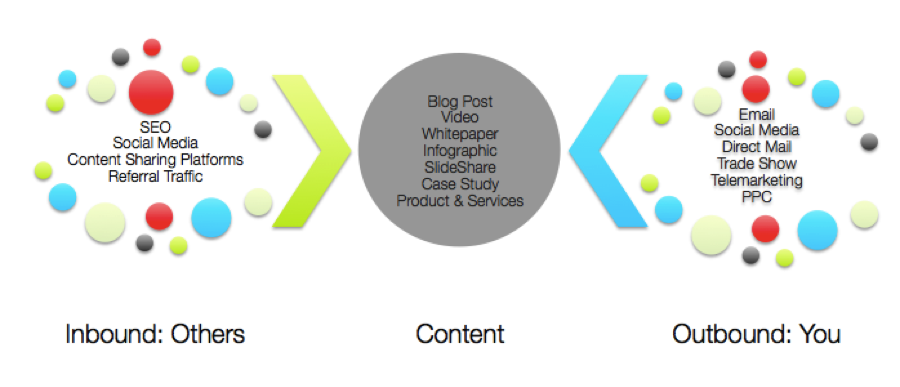Inbound or outbound marketing? It comes up in almost every campaign kick-off or strategy brainstorm. But it's the wrong question at the wrong time. The lines between inbound and outbound marketing are increasingly blurred - it's not an either/or decision. And to reach your audience in a meaningful way, you have to step back from the tactical questions and get the strategy locked down first.
So forget inbound vs. outbound marketing. Instead, think unbound.
In today’s fragmented, multi-screen world, you need to unlock the substance of your story from the structure of your campaigns - and set your content free. “Unbound marketing” takes a holistic, integrated approach, where inbound and outbound work together for a better result. Unbound marketing incorporates the entire spectrum of touch points, with content at the center.
Marketing strategist Ardath Albee says inbound needs outbound to succeed: "Inbound is definitely critical for marketing in today's overwhelming informational environments," she says. "But I'd argue that inbound doesn't actually work without outbound. It's all in how you incorporate the two disciplines."
For example, outbound tactics in paid and owned channels seed your content, which drives social sharing and inbound traffic via social. This drives increased discussion and backlinks, as well as referral traffic and an improved SEO profile.
With that in mind, here are three steps to take before you start drawing boxes and arrows on your campaign whiteboard.
Step 1: Start with a story.
“You don't write because you want to say something; you write because you have something to say.”
— F. Scott Fitzgerald
We have to move beyond a campaign mindset and focus on the essence of our stories. What is it that we have to say? What is the human truth that is useful, helpful, functional, or entertaining? Make your customer (or prospective customer) the hero of your story. And build your narrative around her interests, needs, and ultimate success.
Tools:
- Buyer personas
- Buyer journeys
- Messaging framework
Related Class: Demand Generation: Personas
Step 2: Explore the ecosystem.
It may sound obvious, but consider your audience and the world they live in. What do they care about? Who do they hang out with? Where do they go for information? Think about all the possible connection points where people could be exposed to your content. And remember that they, not you, are choosing the adventure.
Now you can create a multi-faceted engagement plan that puts the customer at the center of your story and encompasses both inbound and outbound channels.
Tools:
- Social media monitoring (e.g., Radian6, Sysomos, Viralheat)
- Influencer and content discovery (e.g., Alltop, Little Bird, Traackr)
- Web analytics (e.g., Google Analytics, Adobe Omniture, Webtrends)
Step 3: Create flexible content, unfettered by format.
Audience preferences should also inform the types of content you create and the way you publish it. Do they download (or even print) in-depth articles from their desktop? Or do they prefer to watch short videos on their tablet or phone? Your content strategy needs to account for all the different ways people will access and view your content (Karen McGrane’s book Content Strategy for Mobile is a fabulous guide).
But don’t get too hung up on format. The same core piece of content may take different forms, depending on context. So create structured microelements that can adapt to multiple channels, formats, and devices. These elements might include:
- Page title
- Meta description
- Open graph copy (for Facebook, LinkedIn, and Google+)
- Social sharing copy (for tweets and status updates)
- Headline
- Subheads
- Body copy
- Images (with sizing/cropping for different display resolutions)
- Captions
- Alt text
- Embedded assets (video, slide decks)
- Call to action
- Links
Fortunately, there are some helpful technology platforms to make all this easier, including your CMS, as well as more comprehensive solutions such as Kapost or Compendium. If a paid platform is beyond your reach, an Excel spreadsheet can do the trick.
Tools:
- Content matrix: Capture all the relevant elements such as those listed above.
- Editorial calendar: Map out the content you will publish, including who, what, when, where, etc.
- Content management and/or workflow systems: Plan, manage, and report on your content production and publication process.
Once you've taken these critical strategic steps, you can put on your campaign hat and start connecting the dots. And when someone asks whether you're doing inbound or outbound, you can simply say, "Yes."
